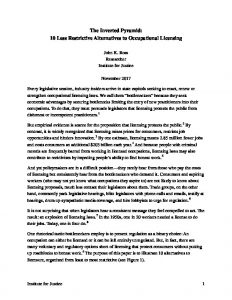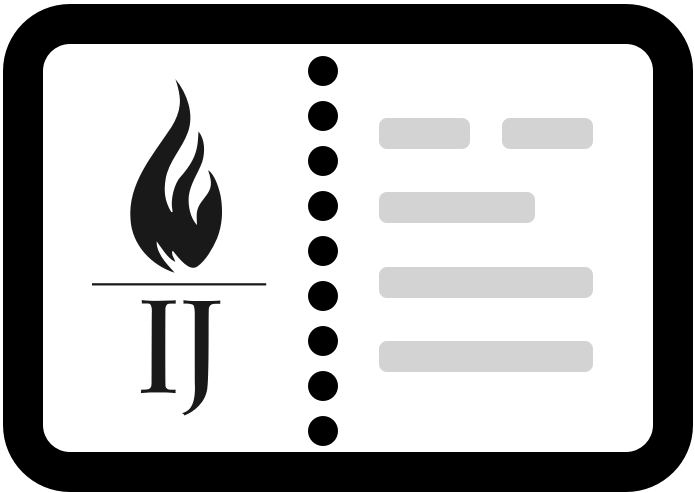Appendix C: Research on Occupational Licensing
The Inverted Pyramid: 10 Less Restrictive Alternatives to Occupational Licensing
 When it comes to occupational regulation, policymakers may see their options as action or inaction: licensing or no licensing. In fact, policymakers can choose from a plethora of alternatives that provide the purported benefits of licensing, without the downsides. This paper discusses 10 less restrictive alternatives to licensing that can protect consumers as well as or better than licensing, without shutting people out of work. It makes the case that before imposing, or continuing to impose, any occupational regulation, policymakers should demand systematic, empirical evidence of harm—and then select the least restrictive and most appropriate option to provide the desired consumer protections.
When it comes to occupational regulation, policymakers may see their options as action or inaction: licensing or no licensing. In fact, policymakers can choose from a plethora of alternatives that provide the purported benefits of licensing, without the downsides. This paper discusses 10 less restrictive alternatives to licensing that can protect consumers as well as or better than licensing, without shutting people out of work. It makes the case that before imposing, or continuing to impose, any occupational regulation, policymakers should demand systematic, empirical evidence of harm—and then select the least restrictive and most appropriate option to provide the desired consumer protections.
Carpenter, D. M. (2012). Testing the utility of licensing: Evidence from a field experiment on occupational regulation. Journal of Applied Business and Economics, 13(2), 28–41. http://www.na-businesspress.com/JABE/CarpenterDM_Web13_2_.pdf
Carpenter, D. M., & McGrath, L. (2014). The balance between public protection and the right to earn a living [Resource brief]. Lexington, KY: Council on Licensure, Enforcement and Regulation. http://ij.org/report/the-balance-between-public-protection-and-the-right-to-earn-a-living/
Department of the Treasury Office of Economic Policy, Council of Economic Advisers, & Department of Labor. (2015). Occupational licensing: A framework for policymakers. Washington, DC: White House. https://obamawhitehouse.archives.gov/sites/default/files/docs/licensing_report_final_nonembargo.pdf
Erickson, A. C. (2013). White out: How dental industry insiders thwart competition from teeth-whitening entrepreneurs. Arlington, VA: Institute for Justice. http://ij.org/report/white-out/
Erickson, A. C. (2016a). Barriers to braiding: How job-killing licensing laws tangle natural hair care in needless red tape. Arlington, VA: Institute for Justice. http://ij.org/report/barriers-to-braiding/
Erickson, A. C. (2016b). Putting licensing to the test: How licenses for tour guides fail consumers—and guides. Arlington, VA: Institute for Justice. http://ij.org/report/putting-licensing-test/
Fetsch, E. (2016). No bars: Unlocking the economic power of the formerly incarcerated. Kansas City, MO: Ewing Marion Kauffman Foundation. http://www.kauffman.org/~/media/kauffman_org/microsites/mayors2016/occupational%20licensing%20and%20the%20formerly%20incarcerated_final.pdf
Flanders, W., & Roth, C. (2017). Fencing out opportunity: The effect of licensing regulations on employment. Milwaukee, WI: Wisconsin Institute for Law and Liberty. http://www.will-law.org/wp-content/uploads/2017/03/FOO2-FINAL-v3.pdf
Fontinelle, A., Mitchell, D., & Snyder, T. (2016). Unnatural rights in the natural state: Occupational licensing in Arkansas. Conway, AR: Arkansas Center for Research in Economics, University of Central Arkansas. http://uca.edu/acre/files/2014/07/ACRE_OccupationalLicensing_InteractiveWeb.pdf
Gius, M. (2016). Waiting to work: The effects of occupational licensing on wages and employment. Hartford, CT: Yankee Institute for Public Policy. http://www.yankeeinstitute.org/wp-content/uploads/2016/11/16-312-YI_CCW_OccupationalLicensing_Study_web-1.pdf
Hall, J. C., & Pokharel, S. B. (2016). Barber licensure and the supply of barber shops: Evidence from U.S. states. Cato Journal, 36(3), 647–657.
Hemphill, T. A., & Carpenter, D. M. (2016). Occupations: A hierarchy of regulatory options. Regulation, 39(3), 20–24. https://object.cato.org/sites/cato.org/files/serials/files/regulation/2016/9/regulation-v39n3-5_0.pdf
Indiana Professional Licensing Agency. (2014). SEA 421 Report: Establishing a process for self-certification registration: A playbook for future occupational regulation in Indiana. Indianapolis, IN. https://www.in.gov/pla/files/IPLA_Legislative_Report_-_Self-Certification_Registration.pdf
Johnson, E., Aggarwal, S., Bezjak, S, Butitova, D., Islam, M. M., & Poudel, H. (2016). Occupational licensing and women entrepreneurs in Missouri: A report to the Women’s Foundation (IPP Research Report). The Women’s Foundation. https://static1.squarespace.com/static/545815dce4b0d75692c341a8/t/582b2125e4fcb54bebfd651e/1479221544420/OL+and+Women+Entrepreneurs+in+MO+-+Final+11.14.16.pdf
Kleiner, M. M. (2015a). Guild-ridden labor markets: The curious case of occupational licensing. Kalamazoo, MI: W.E. Upjohn Institute for Employment Research. http://research.upjohn.org/cgi/viewcontent.cgi?article=1254&context=up_press
Kleiner, M. M. (2015b). Reforming occupational licensing policies (Discussion Paper 2015-01). Washington, DC: The Hamilton Project, Brookings Institution. https://www.brookings.edu/wp-content/uploads/2016/06/THP_KleinerDiscPaper_final.pdf
Kleiner, M. M., & Vorotnikov, E. (2017). Analyzing occupational licensing among the states. Journal of Regulatory Economics. https://link.springer.com/article/10.1007/s11149-017-9333-y
Kleiner, M. M., Marier, A., Park, K. W., & Wing, C. (2016). Relaxing occupational licensing requirements: Analyzing wages and prices for a medical service. Journal of Law and Economics, 59(2), 261–291.
Laird, M., Moore, A., & Staley, S. (2016). Occupational licensing in Florida: Unnecessary licenses are killing jobs (Policy Brief No. 131). Los Angeles, CA: Reason Foundation. http://reason.org/files/occupational_licensing_florida.pdf
Little Hoover Commission. (2016). Jobs for Californians: Strategies to ease occupational licensing barriers (Report #234). Sacramento, CA. http://www.lhc.ca.gov/sites/lhc.ca.gov/files/Reports/234/Report234.pdf
Meehan, B., & Benson, B. L. (2015). The occupations of regulators influence occupational regulation: Evidence from the US private security industry. Public Choice, 162(1), 97–117.
Mellor, W., & Carpenter, D. M. (2016). Bottleneckers: Gaming the government for power and private profit. New York, NY: Encounter Books.
Nunn, R. (2016). Occupational licensing and American workers. Washington, DC: The Hamilton Project, Brookings Institution. https://www.brookings.edu/wp-content/uploads/2016/07/occupational_licensing_and_the_american_worker.pdf
Pizzola, B., & Tabarrok, A. (2017). Occupational licensing causes a wage premium: Evidence from a natural experiment in Colorado’s funeral services industry. International Review of Law and Economics, 50, 50–59.
Rodriguez, M. N., & Avery, B. (2016). Unlicensed and untapped: Removing barriers to state occupational licenses for people with records. New York, NY: National Employment Law Project. http://nelp.org/content/uploads/Unlicensed-Untapped-Removing-Barriers-State-Occupational-Licenses.pdf
Roth, C., & Ramlow, E. (2016). Fencing out opportunity: Occupational licensing in the Badger State. Milwaukee, WI: Wisconsin Institute for Law and Liberty. http://www.will-law.org/wp-content/uploads/2016/11/Licensure-FINAL.pdf
Skorup, J. (2017). This isn’t working: How Michigan’s licensing laws hurt workers and consumers. Midland, MI: Mackinac Center for Public Policy. https://www.mackinac.org/archives/2017/s2017-02.pdf
Slivinski, S. (2015). Bootstraps tangled in red tape: How state occupational licensing hinders low-income entrepreneurship (Policy Report No. 272). Phoenix, AZ: Goldwater Institute. https://goldwater-media.s3.amazonaws.com/cms_page_media/2015/4/15/OccLicensingKauffman.pdf
Slivinski, S. (2016). Turning shackles into bootstraps: Why occupational licensing reform is the missing piece of criminal justice reform (Policy Report No. 2016-01). Tempe, AZ: Center for the Study of Economic Liberty, Arizona State University. https://research.wpcarey.asu.edu/economic-liberty/wp-content/uploads/2016/11/CSEL-Policy-Report-2016-01-Turning-Shackles-into-Bootstraps.pdf
Smith, D. J. (2014). Reforming occupational licensing in Alabama. Troy, AL: Manuel H. Johnson Center for Political Economy, Troy University. https://nebula.wsimg.com/f298ad4627c3d5c72150a568437623a8?AccessKeyId=F0B126F45D4E1A4094F7&disposition=0&alloworigin=1
Snyder, T. J. (2016). The effects of Arkansas’ occupational licensure regulations. Conway, AR: Arkansas Center for Research in Economics, University of Central Arkansas. http://uca.edu/acre/files/2016/06/The-Effects-of-Arkansas-Occupational-Licensure-Regulations-by-Dr.-Thomas-Snyder.pdf
Svorny, S. V. (2015). Asymmetric information and medical licensure. Cato Unbound. https://www.cato-unbound.org/2015/04/10/shirley-v-svorny/asymmetric-information-medical-licensure
Tabarrok, A., & Cowen, T. (2015). The end of asymmetric information. Cato Unbound. https://www.cato-unbound.org/2015/04/06/alex-tabarrok-tyler-cowen/end-asymmetric-information
Thierer, A., Koopman, C., Hobson, A., & Kuiper, C. (2015). How the internet, the sharing economy, and reputational feedback mechanisms solve the “lemons problem” (Mercatus Working Paper). Arlington, VA: Mercatus Center, George Mason University. https://www.mercatus.org/system/files/Thierer-Lemons-Problem.pdf
Timmons, E. J., & Mills, A. (2015). Bringing the effects of occupational licensing into focus: Optician licensing in the United States (Mercatus Working Paper). Arlington, VA: Mercatus Center, George Mason University. https://www.mercatus.org/system/files/Timmons-OpticianLicensing.pdf


